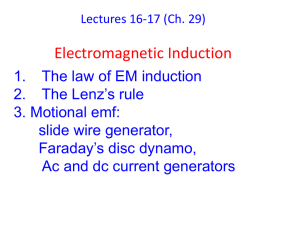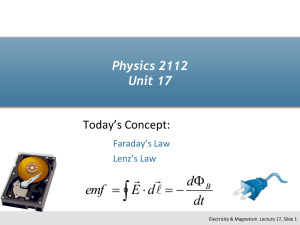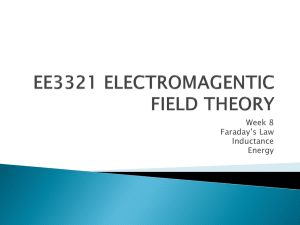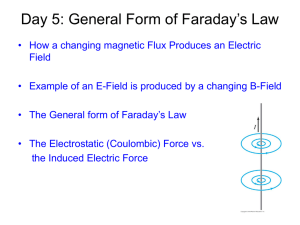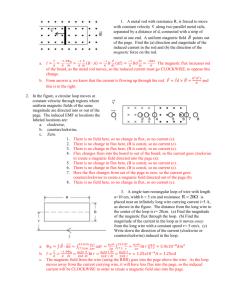Adobe Acrobat file ()
advertisement
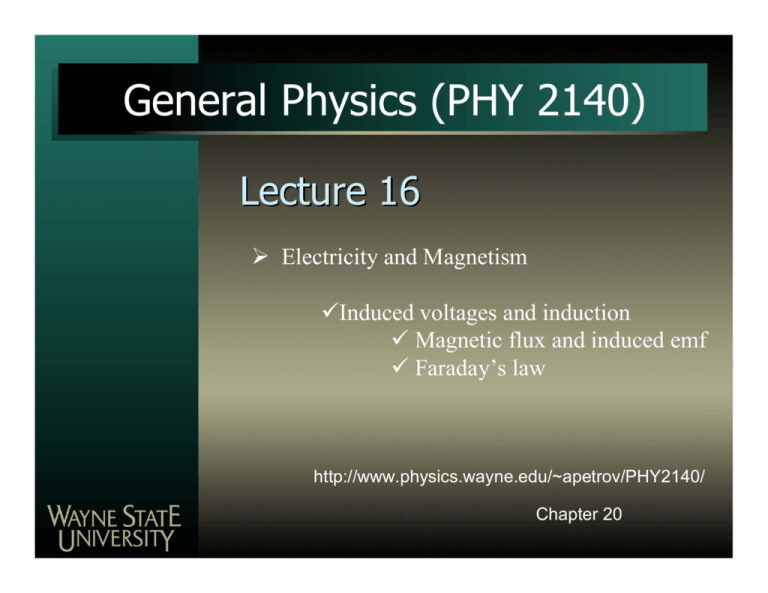
General Physics (PHY 2140) Lecture 16 ¾ Electricity and Magnetism 9Induced voltages and induction 9 Magnetic flux and induced emf 9 Faraday’s law http://www.physics.wayne.edu/~apetrov/PHY2140/ Chapter 20 10/9/2003 1 Lightning Review Last lecture: 1. Magnetism 9 Ampere’s law and applications 2. Induced voltages and induction 9 Magnetic flux µ0 I B= 2π r B = µ0 nI Φ = BA cos θ Review Problem: A sphere of radius R is placed near a long, straight wire that carries a steady current I. The magnetic field generated by the current is B. The total magnetic flux passing through the sphere is 1. µoI. 2. µoI /(4 πR2). 3. 4 πR2 µoI 4. zero. 5. need more information 10/9/2003 2 Recall: right hand rule II 10/9/2003 3 20.1 Induced EMF and magnetic flux Faraday’s experiment Picture © Molecular Expressions 10/9/2003 Two circuits are not connected: no current? However, closing the switch we see that the compass’ needle moves and then goes back to its previous position Nothing happens when the current in the primary coil is steady But same thing happens when the switch is opened, except for the needle going in the opposite direction… What is going on? 4 20.2 Faraday’s law of induction Induced current I 10/9/2003 v S N 5 20.2 Faraday’s law of induction I v B S I N B I 10/9/2003 v A current is set up in the circuit as long as there is relative motion between the magnet and the loop. 6 Does there have to be motion? I (induced) I - + AC Delco 1 volt 10/9/2003 7 Does there have to be motion? I - + AC Delco 1 volt 10/9/2003 8 Does there have to be motion? I (induced) - + AC Delco 1 volt 10/9/2003 9 NO!! Does there have to be motion? - + AC Delco 1 volt 10/9/2003 10 Maybe the B-field needs to change….. B 10/9/2003 v 11 Maybe the B-field needs to change….. I B 10/9/2003 v 12 Maybe the B-field needs to change….. I I v B 10/9/2003 I 13 Faraday’s law of magnetic induction In all of those experiment induced EMF is caused by a change in the number of field lines through a loop. In other words, The instantaneous EMF induced in a circuit equals the rate of change of magnetic flux through the circuit. E= Lenz’s law ∆Φ N ∆t The number of loops matters Lenz’s Law: The polarity of the induced emf is such that it produces a current whose magnetic field opposes the change in magnetic flux through the loop. That is, the induced current tends to maintain the original flux through the circuit. 10/9/2003 14 Applications: Ground fault interrupter Electric guitar SIDS monitor Metal detector … 10/9/2003 15 Example 1: EMF in a loop A wire loop of radius 0.30m lies so that an external magnetic field of strength +0.30T is perpendicular to the loop. The field changes to -0.20T in 1.5s. (The plus and minus signs here refer to opposite directions through the loop.) Find the magnitude of the average induced emf in the loop during this time. JG B 10/9/2003 16 A wire loop of radius 0.30m lies so that an external magnetic field of strength +0.30T is perpendicular to the loop. The field changes to -0.20T in 1.5s. (The plus and minus signs here refer to opposite directions through the loop.) Find the magnitude of the average induced emf in the loop during this time. Given: r = 0.30 m Bi = 0.30 T Bf = -0.20 T ∆t = 1.5 s The loop is always perpendicular to the field, so the normal to the loop is parallel to the field, so cosθ = 1. The flux is then Φ = BA = Bπ r 2 Initially the flux is Φi = ( 0.30T ) π ( 0.30m ) =0.085 T ⋅ m 2 2 Find: EMF=? and after the field changes the flux is Φ f = ( −0.20T ) π ( 0.30m ) =-0.057 T ⋅ m2 2 The magnitude of the average induced emf is: ∆Φ Φ f − Φi 0.085 T ⋅ m 2 -0.057 T ⋅ m 2 emf = = = = 0.095V 1.5s ∆t ∆t 10/9/2003 17 Example 2: EMF of a flexible loop The flexible loop in figure below has a radius of 12cm and is in a magnetic field of strength 0.15T. The loop is grasped at points A and B and stretched until it closes. If it takes 0.20s to close the loop, find the magnitude of the average induced emf in it during this time. X X X A X X X X X X X X X X X X X 10/9/2003 B 18 20.3 Motional EMF l B F v Let's consider a conducting bar moving perpendicular to a uniform magnetic field with constant velocity v. F = qvB sin θ 10/9/2003 This force will act on free charges in the conductor. It will tend to move negative charge to one end, and leave the other end of the bar with a net positive charge. 19 Motional EMF The separated charges will create an electric field which will tend to pull the charges back together. When equilibrium exists, the magnetic force, F=qvB, will balance the electric force, F=qE, such that a free charge in the bar will feel no net force. Thus, at equilibrium, E = vB. The potential difference across the ends of the bar is given by ∆V=El or ∆V = El = Blv A potential difference is maintained across the conductor as long as there is motion through the field. If the motion is reversed, the polarity of the potential difference is also reversed. 10/9/2003 20 Motional EMF – conducting rails R ∆x B v We can apply Faraday's law to the complete loop. The change of flux through the loop is proportional to the change of area from the motion of the bar: ∆Φ = BA = Bl ∆x 10/9/2003 current I= or (Faraday’s law) E Blv = R R ∆Φ ∆x E= = Bl = Blv ∆t ∆t Motional EMF 21 Example: wire in the magnetic field Over a region where the vertical component of the Earth's magnetic field is 40.0µT directed downward, a 5.00 m length of wire is held in an east-west direction and moved horizontally to the north with a speed of 10.0 m/s. Calculate the potential difference between the ends of the wire, and determine which end is positive. 10/9/2003 22 20.4 Lenz’s law revisited Application of Lenz's law will tell us the direction of induced currents, the direction of applied or produced forces, and the polarity of induced emf's. Lenz's law says that the induced current will produce magnetic flux opposing this change. To oppose an increase into the page, it generates magnetic field which points out of the page, at least in the interior of the loop. Such a magnetic field is produced by a counterclockwise current (use the right hand rule to verify). 10/9/2003 23 Lenz’s law: energy conservation We arrive at the same conclusion from energy conservation point of view The preceding analysis found that the current is moving ccw. Suppose that this is not so. If the current I is cw, the direction of the magnetic force, BlI, on the sliding bar 10/9/2003 would be right. This would accelerate the bar to the right, increasing the area of the loop even more. This would produce even greater force and so on. In effect, this would generate energy out of nothing violating the law of conservation of energy. Our original assertion that the current is cw is not right, so the current is ccw! 24 S S v The induced flux seeks to counteract the change. N change 10/9/2003 S S N v N change 25 Example: direction of the current Find the direction of the current induced in the resistor at the instant the switch is closed. 10/9/2003 26 Applications of Magnetic Induction Tape / Hard Drive / ZIP Readout Tiny coil responds to change in flux as the magnetic domains (encoding 0’s or 1’s) go by. Question: How can your VCR display an image while paused? Credit Card Reader – Must swipe card Æ generates changing flux Faster swipe Æ bigger signal 10/9/2003 27
